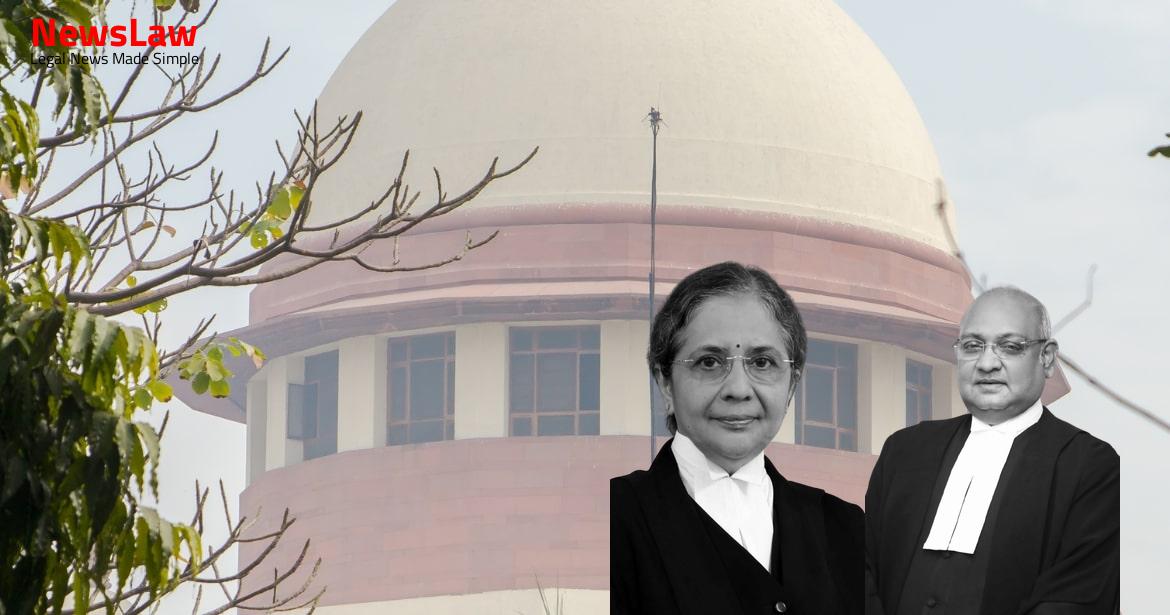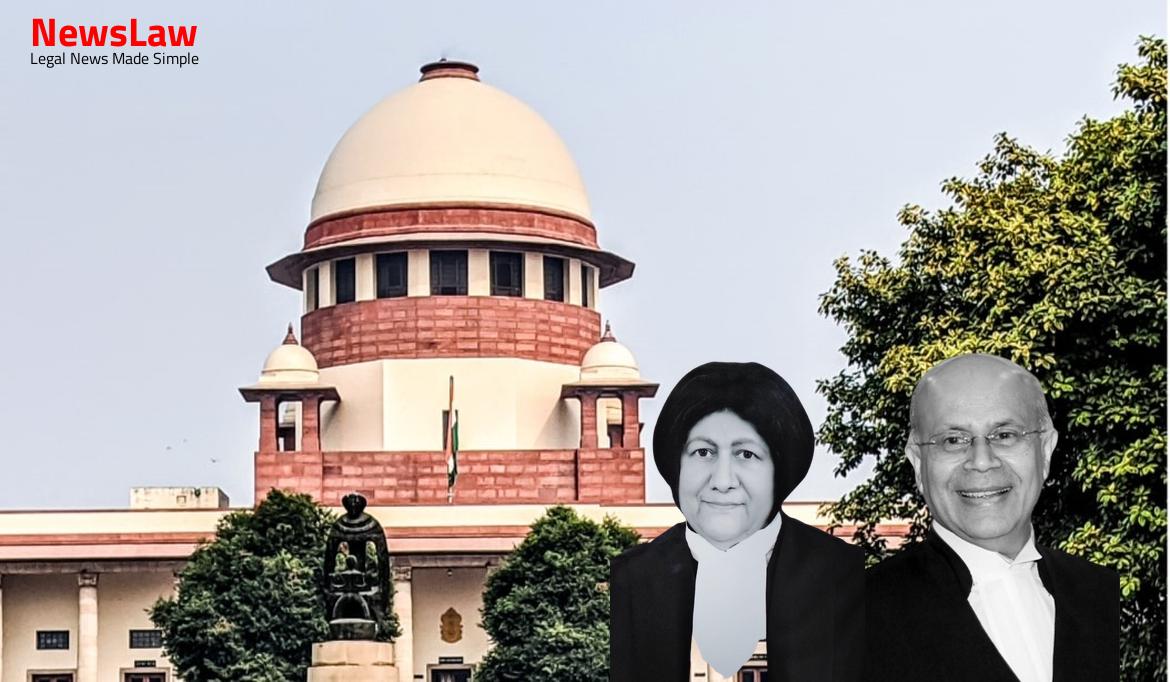In a landmark judgment by the Supreme Court of India, the case of Justice vs. Compassion has sparked debates on the fine line between legal justice and human empathy. Delve into the intricate details of this case that grapples with the fundamental aspects of the law and morality. This judgment sets a precedent for future decisions in balancing the scales of justice and compassion.
Facts
- The High Court engaged in considering the quantum of sentence and the application of the R.R. Test to the case.
- After analyzing the ‘aggravating’ and ‘mitigating’ circumstances, the High Court upheld the death penalty awarded by the trial Court.
- Arguments raised by the appellant’s counsel regarding the appellant’s innocence and inconsistencies in the evidence.
- The High Court confirmed the death sentence based on the conclusive evidence linking the appellant to the crime.
- Key factual issues considered by the High Court included the presence of the accused with the victim in a locked house, multiple injuries on the victim, medical evidence of rape and murder, recovery of incriminating clothing, motive, and failure of the accused to explain incriminating circumstances.
- The appellant, along with his relatives, started looking for the missing child after the victim was found in a critical condition in his house.
- The appellant’s blood samples were taken for DNA examination, and it was found that the victim had been subjected to multiple injuries.
- Informant received information about the appellant distributing chocolates to children in the vicinity, leading to suspicions.
- The police found the victim in a critical condition, covered with injuries, and pronounced her dead upon reaching the hospital.
- A panel of doctors conducted a post-mortem revealing various injuries on the victim’s body, indicating foul play.
- The appellant denied the accusations and claimed innocence, stating that he was falsely implicated.
- The prosecution presented 12 witnesses, and multiple charges including Section 377 were framed against the appellant.
- The appellant’s blood samples were taken again for a DNA test, and he was arrested by the Investigating Officer.
- Seizure of clothes worn by the appellant and the victim was done in the presence of witnesses, confirming the crucial evidence collected.
Also Read: Ensuring Justice: Amanatullah Khan vs. Commissioner of Police, Delhi – A Landmark Case
Issue
- Whether the prosecution proves that the accused kidnapped a minor girl under 16 years of age from her lawful guardianship without consent, and thereby committed an offense punishable under section 363 of the IPC.
- Whether the prosecution further proves that the accused committed rape on the aforementioned minor girl, thereby committing an offense punishable under section 376 of the IPC.
- Whether the prosecution further proves that the accused committed carnal intercourse against the order of nature with the minor girl, thereby committing an offense punishable under section 377 of the IPC.
Also Read: State of Kerala vs. Union of India: Fiscal Responsibility Case
Arguments
- Appellant’s Counsel argued against imposition of the death penalty, stating that the nature of the crime alone is not sufficient to warrant it.
- There are discrepancies in the testimonies of witnesses regarding the details of the crime scene and the actions of the appellant.
- The prosecution failed to establish the authenticity of the blood sample taken from the appellant, leading to doubt over the DNA match.
- The Courts did not adequately consider mitigating factors such as the appellant’s age, lack of criminal history, and socio-economic background before imposing the death penalty.
- Several three-Judge Bench decisions cited where death sentences were commuted due to similar circumstances.
- Reference to a specific case where death penalty was substituted with life imprisonment based on circumstantial evidence and potential for reformation.
- The Learned State Counsel refuted all the appellant’s contentions and highlighted the ocular and medical evidence, emphasizing the eye-witness’s account.
- Specifically, the State Counsel defended the reliance on DNA evidence, even though the Y-Chromosome Short Tandem Repeat Polymorphism (Y-STR) method used has limitations in accurate identification.
- The argument was made that Y-STR analysis, unlike autosomal STR analysis, does not allow for individual identification within the same male lineage.
- It was concluded that the prosecution’s failure to establish guilt beyond a reasonable doubt warrants giving the appellant the benefit of doubt.
Also Read: R.C. Sabharwal vs. Income Tax Department
Analysis
- Strong circumstantial evidence, eye-witness accounts, medical evidence, and DNA analysis conclusively prove the appellant’s guilt in the horrendous crime.
- The victim, a minor child, was subjected to forcible vaginal and anal intercourse, leading to asphyxia due to throttling.
- The appellant was known by witnesses since childhood and seen distributing chocolates to children on the day of the crime.
- Witnesses observed the appellant taking away the victim child, who went missing around 4:00 p.m.
- The appellant was found outraging the modesty of the victim child under the bed by witnesses who broke into the house.
- DNA analysis matched the appellant’s samples with those found on the victim and the crime scene, providing solid scientific evidence.
- The brutality of the crime, involving rape and murder of minors, led to the confirmation of the death penalty.
- The sentencing policy aims to strike a balance between deterrence and reformation, aligning with legislative changes introducing capital punishment for heinous crimes.
- The appellant showed no remorse, repentance, or acceptance of guilt, indicating a lack of potential for reformation.
- Lack of motive is not fatal to the case, as the circumstantial evidence and DNA analysis are strong indicators of the appellant’s guilt.
- Witnesses observed blood-stains and semen stains on the appellant’s clothing, further connecting him to the crime scene.
- The death sentence was confirmed by the High Court based on the horrifying nature of the crime and the appellant’s lack of mitigating circumstances.
- Y-STR DNA analysis, though criticized, was deemed reliable and crucial in corroborating evidence in sexual assault cases.
- In the case of Machhi Singh v. State of Punjab (1980), the Court formulated two questions to determine the rarest of the rare cases for which death sentence can be given.
- The community’s sentiment plays a significant role when the crime is viewed based on motive, manner of commission, or the anti-social nature of the crime.
- Extreme brutality and shocking nature of the crime can lead to the imposition of the death penalty as per the collective conscience of society.
- The judiciary upholds the award of capital punishment in cases of extreme depravity and heinous crimes.
- Factors such as the manner of commission, motive for murder, and socially abhorrent nature of the crime contribute to the decision of death sentence.
- The gravity of the offense and extreme culpability are crucial considerations for awarding the death sentence.
- The sentencing procedure must have a society-centric approach, emphasizing the importance of reverence for life.
- A balance is maintained between deterrence and humanity in deciding the appropriateness of death penalty in exceptional cases.
- The court must adhere to strict parameters and ensure that the death sentence is not arbitrary or capricious in its imposition.
- A person who commits aggravated penetrative sexual assault on a child below the age of 12 years shall be punished with rigorous imprisonment.
- The fine imposed should be just and reasonable, paid to the victim for medical expenses and rehabilitation.
- The punishment for this offense can be imprisonment for the remainder of natural life or death.
- Recent amendment in the Act increased the minimum term of imprisonment to twenty years for aggravated penetrative sexual assault.
- The maximum punishment remains imprisonment for life or with the death penalty.
Decision
- Appeals were dismissed
- Death sentence affirmed
Case Title: RAVI Vs. THE STATE OF MAHARASHTRA
Case Number: Crl.A. No.-001488-001489 / 2018



